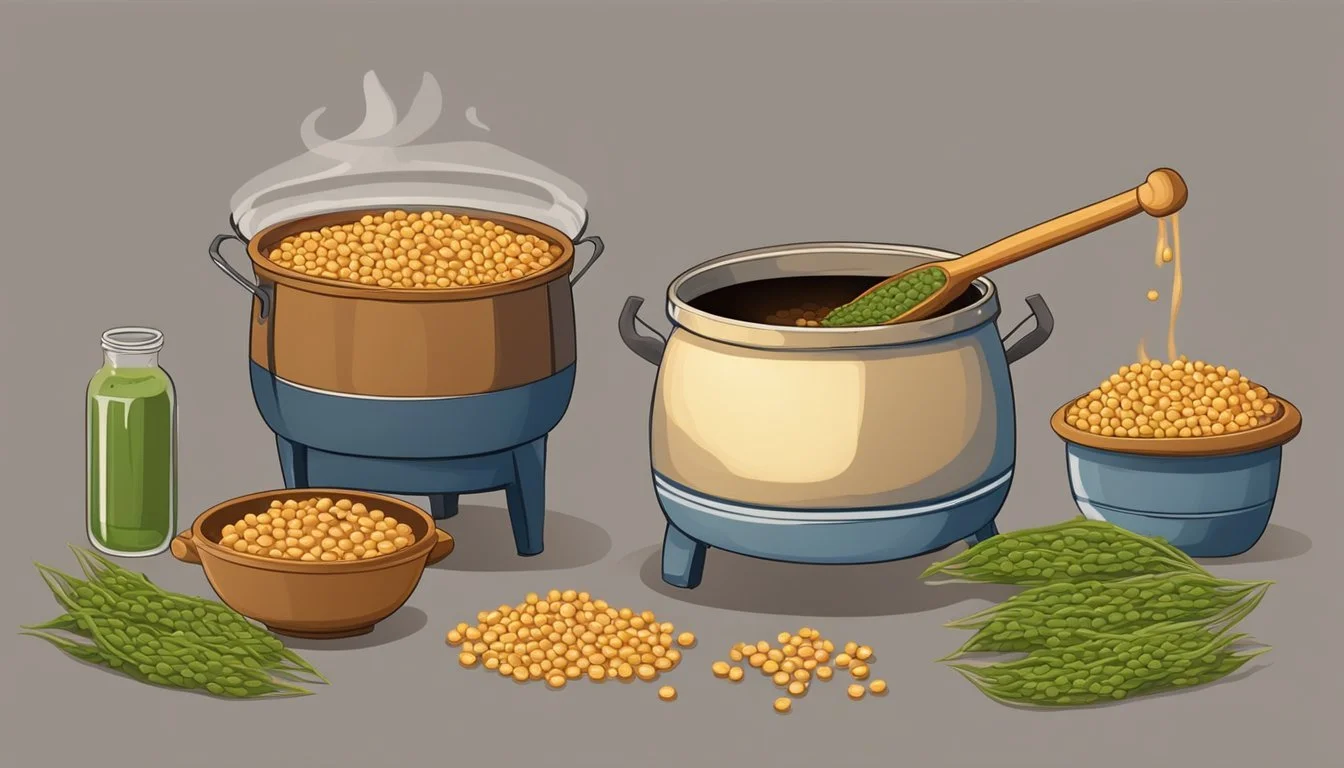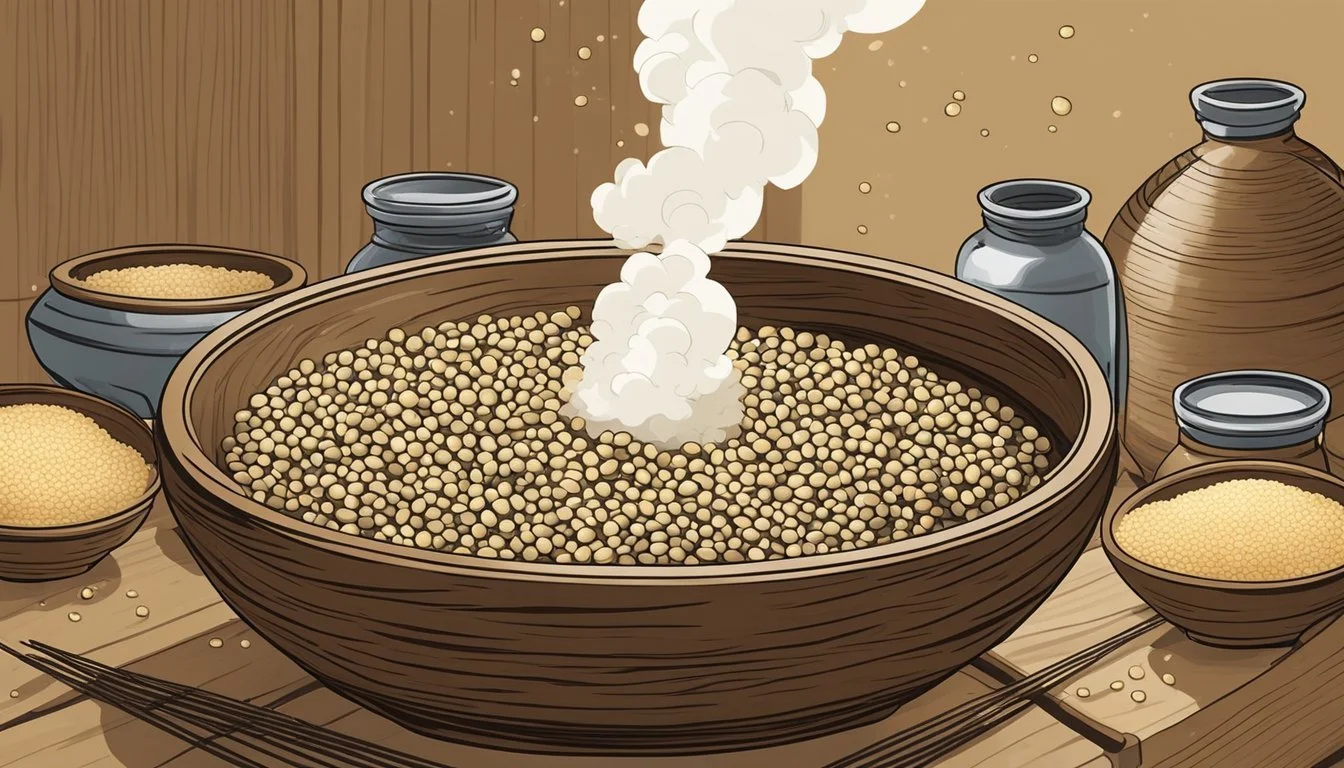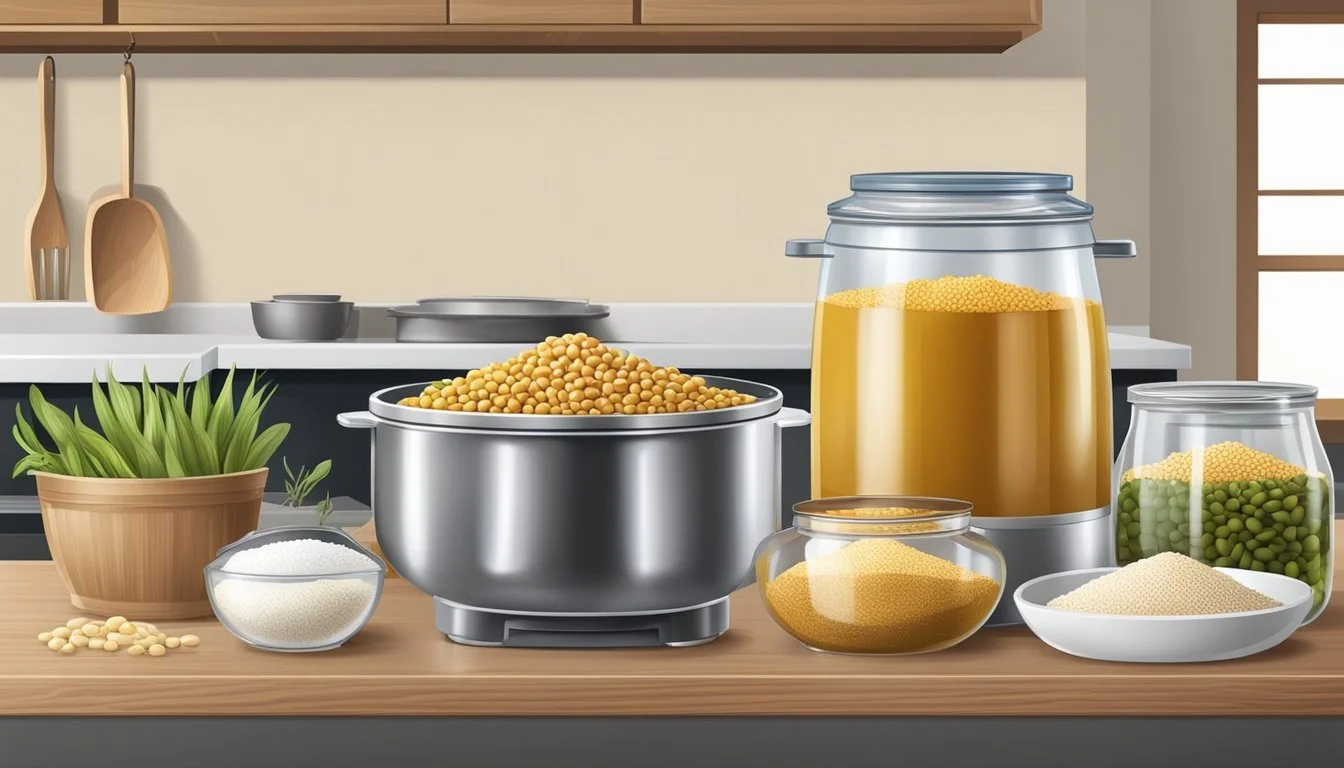How to Ferment Doenjang
Mastering Traditional Korean Soybean Paste
Doenjang, a staple in Korean cuisine, is a fermented soybean paste known for its rich umami flavor profile and health benefits. This traditional condiment is the result of a time-honored fermentation process that transforms simple soybeans into a complex, deeply flavored paste. High in protein and rich in probiotics, doenjang is not just an essential ingredient in Korean cooking but also contributes to a balanced diet.
The production of doenjang involves a series of steps that require careful attention to detail. It begins with soaking and boiling soybeans before mashing them into a paste. This paste is then shaped into blocks and left to ferment, which can take several months. During fermentation, beneficial bacteria break down the beans, imbuing the paste with its characteristic savory depth.
Once fermentation is complete, doenjang can be used in a variety of dishes, from stews and soups to marinades and sauces. Its bold flavor enhances the taste of vegetables, meats, and tofu, exemplifying its versatility in the kitchen. Whether used in a traditional doenjang jjigae (soybean paste stew) or as a flavorful addition to a salad dressing, the importance of doenjang in Korean gastronomy is indisputable.
Historical Background of Doenjang
Doenjang is a cornerstone of Korean cuisine, with a tradition of fermentation that dates back thousands of years. This fermented soybean paste has been an integral part of Korean cooking, providing a depth of flavor and nutritional benefits.
Origins: Historical records trace the use of soybeans in Korea to around 544 CE, thereby hinting at the ancient origins of doenjang. The art of fermentation was likely developed out of necessity, as a means of preserving food and enhancing its flavor.
Process Evolution: The primary components of doenjang are soybeans and brine. Over centuries, Koreans have mastered the fermentation process, which has two significant byproducts: doenjang (soybean paste) and ganjang (soy sauce).
Culinary Significance: Doenjang's umami-rich taste is prized in Korean cooking, commonly used in soups, stews, and marinades. It carries the soul of traditional Korean home cooking.
Cultural Impact:
Essential Ingredient: In Korea, doenjang is more than a seasoning; it is a cultural staple that has stood the test of time.
Health Perception: It is revered for its health effects, as fermentation not only enhances the flavor but also increases the paste's nutritional value.
Through a dedication to the age-old method of fermentation, doenjang remains an indispensable element in Korean cuisine, and its use is a testament to the lasting heritage of Korean culinary practices.
Understanding Doenjang Ingredients
Doenjang, a traditional Korean fermented soybean paste, is created with minimal ingredients yet yields a complex flavor profile. Understanding the components is crucial for both quality and authenticity.
Key Ingredients for Doenjang
Soybeans: The primary ingredient for doenjang is dried yellow soybeans. They form the base of the paste and are responsible for its texture and protein content. The soybeans undergo fermentation by the action of Bacillus subtilis and other fungi, which are naturally present on the beans or introduced during the fermentation process.
Salt: Kosher salt is added to the fermented soybean paste to enhance flavor and act as a preservative, ensuring the longevity of doenjang. The salt also regulates the fermentation process, preventing the growth of unwanted bacteria.
Supplementary Ingredients
Garlic and Onion: Finely minced garlic and onion are often incorporated into doenjang for additional flavor. They complement the umami character of the fermented soybeans and add depth to the overall taste.
Honey: A small amount of honey can be included in doenjang. It provides a hint of sweetness that balances the robust savory notes and contributes to a more complex flavor profile.
Under the right conditions, these ingredients combine as they ferment, creating the distinctively rich and umami-packed flavor that doenjang is celebrated for.
Preparing the Doenjang Fermentation Space
Before initiating the fermentation process of Doenjang, one must prepare a suitable environment to ensure optimal conditions for fermentation. The space should be a clean area that is warm and receives a moderate amount of sunlight, which aids in the fermentation process.
Essential elements in the space preparation:
Air circulation: Good air circulation is necessary to prevent mold and spoilage.
Temperature: The ideal temperature range is between 60°F to 75°F (15°C to 24°C).
Protection: A piece of cheesecloth or waxed paper can be used to cover the opening of the container to protect the paste from contaminants while allowing it to breathe.
Suitable containers for fermentation:
Earthenware Crocks: Traditional and effective for even temperature distribution.
Cardboard Boxes: A temporary and cost-effective solution, providing that they are lined and sealed appropriately.
Materials for layering:
Dried Rice Straw or Hay: They can be laid down as a base layer in the container for additional insulation and absorption of excess moisture. If unavailable, cheesecloth may serve as a substitute.
Brine: A layer of saltwater brine may also be used in the process to preserve the soybeans and prevent harmful bacterial growth.
To prepare the space:
Clean the earthenware crock or container thoroughly.
Place the base layer of dried rice straw, hay, or multiple layers of cheesecloth at the bottom of the crock.
If using brine, ensure it has been properly prepared with the correct salinity.
The setup of the fermentation space is vital for the successful transformation of soybeans into flavorful Doenjang. Through careful consideration of these elements, one creates an environment conducive to the development of complex flavors characteristic of this traditional Korean condiment.
Doenjang Fermentation Process
The Doenjang fermentation process is a critical step in achieving the paste's characteristic nutty, umami flavor. This involves a series of stages, with the initial mixing and fermentation, followed by a more prolonged secondary fermentation, and finally aging and storage, which allows the flavors to deepen.
Initial Fermentation
The process begins by mixing steamed soybeans with brine. This salty environment is essential for the first stage of fermentation. The soybeans are mashed and formed into blocks called meju, which are then left to ferment in a warm environment, ensuring the development of a rich, deep flavor. During this initial phase, which usually lasts for a week, the meju blocks will form beneficial molds, which are essential for the development of the paste's unique properties.
Secondary Fermentation
For secondary fermentation, the meju blocks are submerged in brine, often with additional flavor-enhancing ingredients like jujubes and dried hot chili red peppers, which impart a subtle sweetness and heat to the paste. Hardwood charcoal is sometimes added to the fermentation vessel. It is known to purify the brine and contribute to the doenjang's complexity. This stage can take several months, during which the mixture slowly transforms into a thick paste, developing its full spectrum of flavors.
Aging and Storage
The final stage is aging. The paste is packed in earthenware pots or crocks, which allows the doenjang to breathe and continue developing its flavors. Careful storage is vital to prevent unwanted contamination and to ensure that the doenjang matures correctly. The taste will continue to evolve, typically becoming more robust and flavorful, with a pronounced umami and nutty profile, especially if aged for several years. Homemade doenjang can be stored and used for a variety of dishes, enhancing them with its unique taste.
Serving and Cooking with Doenjang
Doenjang, a Korean fermented soybean paste, serves as a versatile ingredient in many Korean dishes, contributing a deep, rich flavor to soups, stews, and sauces. This section explores traditional uses and innovative recipes that highlight doenjang's culinary significance.
Traditional Doenjang Dishes
One can find doenjang at the heart of doenjang jjigae, a staple Korean soup known for its rich and comforting taste. The soup typically combines the umami depth of the soybean paste with ingredients such as tofu, vegetables like zucchini and mushrooms, and sometimes seafood or beef. Kimchi often accompanies dishes to enhance the flavors and provide a spicy kick.
To prepare doenjang jjigae, cooks begin by sautéing ingredients such as onions, garlic, and chili before adding water or broth. Once the base is ready, doenjang is stirred in until it dissolves, followed by the addition of tofu and vegetables. This soup is then simmered to let the flavors meld, resulting in a hearty dish served alongside rice.
Innovative Doenjang Recipes
Beyond traditional soups and stews, chefs are incorporating doenjang into innovative dishes to add a distinct Korean flavor. One can use doenjang as a savory dressing when mixed with sesame oil and garlic, perfect for drizzling over fresh salads and steamed vegetables.
Incorporating doenjang into marinades creates complex flavor profiles for meats and tofu, as the paste's savoriness enhances the proteins' natural tastes. To leverage doenjang in marinades, combine it with ingredients like soy sauce, a hint of sweetness, and aromatic spices. These innovative recipes demonstrate the potential doenjang has to infuse Korean flair into a variety of dishes.
Pairing and Enhancing Flavors
When incorporating doenjang, a deeply fermented soy sauce with a rich, nutty flavor profile, into various dishes, understanding how it complements other ingredients is crucial. In the culinary domain, it's known for its versatility, pairing exceptionally well with an array of vegetables, such as spinach, bok choy, and squash. These vegetables can absorb the bold flavors of doenjang, making it a go-to for seasoning side dishes in Korean cuisine.
For enthusiasts looking to experiment, authentic Korean markets offer a wide selection of commercial doenjang brands. They are available in the fridge section and cater to those who prefer not to prepare the paste from scratch. When using store-bought doenjang, one can enhance its flavor by adding freshly minced scallion or a sprinkle of gochugaru (Korean chili pepper flakes) to the dish.
Doenjang also elevates seafood and mushroom dishes (What Wine Pairs Perfectly with Mushroom Dishes), imparting an umami richness that accentuates their natural flavors. Anchovies, (What wine goes well with anchovies?) in particular, work well with doenjang, creating a harmonious blend for stews and soups.
The following table outlines common flavor combinations with doenjang, providing a guide for those looking to experiment with this savory paste:
Ingredient: Vegetables
Pairing Suggestion: Mix with spinach or bok choy in a salad dressing with sesame oil.
Ingredient: Seafood
Pairing Suggestion: Blend into stews with anchovies for additional depth.
Ingredient: Mushrooms
Pairing Suggestion: Stir-fry with mushrooms for an earthy, umami-rich side dish.
Ingredient: Squash
Pairing Suggestion: Use as a marinade for roasted squash, adding a savory complexity.
Ingredient: Scallion
Pairing Suggestion: Incorporate finely chopped scallion for a crisp, aromatic kick.
Ingredient: Gochugaru
Pairing Suggestion: Sprinkle on top of dishes for a spicy, vibrant finish.
While cooking rice or preparing rice water, a small amount of doenjang can infuse the grains with an enriched flavor that complements traditional Korean sauce-based dishes. This fermentation powerhouse, paired correctly, can transform the simplest ingredients into an aromatic, flavor-rich experience.
Health Benefits and Nutritional Information
Doenjang, a staple in Korean cooking, provides several health benefits due to its rich nutritional profile. It features a distinctive nutty and umami flavor, attributable to the fermentation process which also enhances its health-promoting properties.
Nutritional Breakdown: Doenjang is known for its high protein content, a result of soybeans being the primary component. Protein in doenjang is more bioavailable given its fermented nature.
Fiber: A valuable source, it aids in digestion and helps maintain bowel health.
Vitamins: It contains traces of vitamin E, essential for immune function and skin health.
Minerals: Doenjang provides iron, necessary for red blood cell formation, and calcium, important for bone health.
Health Benefits:
Benefit: Gut Health
Description: Fermentation fosters beneficial bacteria that improve gut flora.
Benefit: Protein Source
Description: Offers essential amino acids for muscle repair and growth.
Benefit: Flavor without Additives
Description: Enhances dishes with umami taste without artificial additives.
Fermented foods like doenjang, when prepared traditionally, come in blocks that can be used in various forms in cooking. As doenjang is fermented, the salt content should be considered, and hence, it should be consumed in moderation within a balanced diet. Despite its salt content, fermentation may mitigate hypertension risks as suggested in studies involving rats.
Incorporating doenjang into one's diet can contribute to a well-rounded intake of various nutrients and can support overall health, provided it is consumed responsibly in the context of an individual's dietary needs.
Storing and Preserving Doenjang
When one has successfully fermented Doenjang, proper storage is crucial for maintaining its quality and flavor, which includes a balance of sweetness, a nutty profile, and umami depth. Preservation begins with selecting the right container: an earthenware crock is traditionally used for its porosity, which allows the Doenjang to breathe and further develop its complex flavors during storage.
Immediate Storing Steps:
Transfer the fermented paste into the earthenware crock.
Pack the Doenjang down to remove air pockets.
Sprinkle a thin layer of salt over the surface; this acts as a natural preservative.
Protection:
Cover the crock with a breathable cotton cloth to prevent contaminants.
Secure the cloth with a rubber band to ensure it stays in place.
Location and Environment:
Store the crock in a cool, dry place.
A location with minimal temperature fluctuations is preferred to maintain the integrity of the fermentation.
Long-term Considerations:
Doenjang's flavor matures over time; it should be checked periodically for any signs of mold.
When maintained properly, the paste can last for several months to several years, with its flavors deepening, and the natural sweetness and nutty notes becoming more pronounced.
By following these steps, one can ensure Doenjang remains a staple condiment, ready to enhance a wide array of dishes with its rich and savory qualities. Remember that care and attention are the key ingredients in preserving the nuanced character of Doenjang.
Finding Doenjang Ingredients
When creating doenjang, the first trip is typically to a Korean grocery store. These stores provide a variety of specific ingredients used in traditional Korean food (What wine goes well with Korean food?) including doenjang itself. The primary ingredient in doenjang is soybeans. One may also wish to add flavor enhancers like minced garlic to the paste during the fermentation process, and this too can be found in Korean markets.
While doenjang is the star for various Korean dishes including stews and side dishes, additional ingredients might be needed for the complete culinary experience. Common vegetables like zucchini and green onions work well within a doenjang-based Korean stew, while proteins such as beef may be added for a richer flavor. For a more carb-centric dish, potato can be a hearty addition.
In contrast to doenjang, gochujang is another well-known Korean fermented paste, but it is distinct with its spicy, sweet flavor and should not be confused with doenjang. Both, however, can be used in side dishes to enhance the meal's profile.
For recipes and inspiration, one might browse Instagram where many cooks share their preparations of traditional and modernized Korean dishes. These platforms offer insights into the use and pairing of doenjang, often showing it in the context of a complete meal.
Any successful doenjang dish starts with sourcing high-quality soybeans and complementary ingredients. Patrons at Korean grocery outlets will be met with a wide variety of choices suitable for authentic doenjang recipes. It's essential to select fresh and, when possible, organic ingredients to ensure the highest quality and taste for your doenjang and accompanying dishes.
Doenjang in Modern Culinary Practices
Doenjang, a staple in Korean cooking, has endured as a beloved condiment with a rich, umami-packed profile, derived from its fermented nature. Chefs and home cooks alike integrate this soybean paste into their culinary repertoire, leveraging its deep flavors and nutritional benefits. It holds a place of reverence on par with ganjang, the liquid soy sauce also born from Korean fermentation traditions.
When crafting homemade doenjang, one appreciates its multifaceted use in modern dishes. The process begins by fermenting soybeans, which are then formed into blocks and aged, resulting in a robust paste. This transformative substance imparts an earthy essence to numerous recipes. Here, we examine its application in contemporary cooking:
Incorporation into dressings: Modern chefs often whisk doenjang with sesame oil and garlic, creating a bold dressing to enhance salads and vegetable sides.
Mixes with fish sauce: A common practice involves melding doenjang with fish sauce to inject a complex flavor into stews and marinades.
Fusion cuisine: It finds its way into innovative fusion cuisines, adding depth to dishes that marry Korean flavors with global gastronomic techniques.
Meat and fish companion: The paste serves as a robust base in marinades for meat and fish, tenderizing while seasoning.
The way doenjang commands a presence in both traditional and modern kitchens showcases its versatility. It moves beyond its origins, forming the backbone of new age recipes that still respect the ingredient’s historical significance. As the culinary world evolves, doenjang remains a timeless component, continuing to adapt to the tastes of the global palate while maintaining its Korean identity.
Doenjang Around the World
Doenjang is a staple in Korean cuisine, renowned for its earthy and umami-rich flavor. As culinary borders blend across the globe, doenjang is finding its place in the kitchens of many international chefs and food enthusiasts.
In traditional Korean dishes, doenjang is essential. Recipes like doenjang-jjigae (fermented soybean paste stew) highlight its deep, savory characteristics. Although its origin is deeply rooted in Korea, doenjang's versatility has made it a valuable ingredient in an array of global recipes.
Fermentation Techniques
Korea: Traditional methods include sun fermentation.
Worldwide Adaptations: Similar fermentation practices are adopted globally, respecting the traditional Korean process.
Usage in International Cuisine
As a marinade base, infusing umami into meats and vegetables.
In dressings, harmonizing with sesame oil and garlic.
As a flavor enhancer for soups and stews, beyond Korean recipes.
Regardless of location, the fermentation process of doenjang requires patience and precision. The paste is typically mashed, shaped into bricks or left chunky, and left to ferment in a warm spot with moderate exposure to sunlight.
Doenjang's global journey reflects an appreciation for Korean culinary traditions, as well as a widespread desire to incorporate rich, complex flavors into a variety of cuisines. Worldwide, cooks are embracing this ingredient, offering a taste of Korea to their local fare.
Frequently Asked Questions About Doenjang
What is Doenjang?
Doenjang is a traditional Korean fermented soybean paste, rich in savory umami flavor. It is a staple ingredient in various Korean dishes and known for its hearty, deep taste.
How is Doenjang made?
Doenjang is made by fermenting boiled soybeans that are mashed and formed into blocks. These blocks, known as meju, are then aged and fermented further with salt and water, producing a thick paste with a deep, complex flavor profile.
What does Doenjang taste like?
It has a distinctly strong and sharp taste with a rich umami character and a slight caramel aroma. Doenjang's flavor is savory, somewhat akin to a more pungent miso paste.
How can one use Doenjang?
Traditionally used in soups, stews, and marinades, doenjang adds depth and a piquant kick to dishes. One of its most famous applications is in Doenjang-jjigae, a robust Korean soybean paste stew.
Use Case: In Soups and Stews
Description: It is diluted with water or broth for a savory base.
Use Case: As a Marinade
Description: Blended with other ingredients for meat or vegetable marinades.
Use Case: Sauce and Seasoning
Description: Mixed with added seasonings for a rich dipping sauce or to enhance vegetable dishes.
Is there a specific way to store Doenjang?
One should keep doenjang in a sealed container within the refrigerator, where it can last for a prolonged period due to its fermented nature.
Can Doenjang be used in place of other soybean pastes?
Due to its unique flavor, doenjang should be used with consideration. It can replace similar fermented soybean pastes like miso, though it will impart a more robust flavor to the dish.
Conclusion
Fermenting doenjang is a treasured process in Korean cuisine that demands patience and meticulous care. The craft of making this indispensable condiment epitomizes the culinary artistry and tradition found in Korean cooking. The resulting paste is not only a staple in many dishes but also a source of rich, umami flavor that characterizes the depth of Korean gastronomy.
Critical to successful fermentation is the initial preparation, where soybeans are well-cooked and shaped into bricks before being fermented with salt. Regular monitoring during the final fermentation phase ensures the paste matures correctly. Once complete, doenjang can elevate the simplest of vegetables or add complexity to a hearty stew.
Through consistent practice and respect for the traditional methods, home chefs can achieve a paste with a distinctive taste that commercially processed variants may not offer. The final product, a harmonious blend of savory and earthy tones, seamlessly integrates into an array of Korean dishes.
Food enthusiasts are encouraged to engage with this fermentation process to appreciate the full spectrum of flavors crafted within a seemingly simple paste. One may find that doenjang far surpasses its role as a condiment, becoming integral to the identity of Korean cooking.










